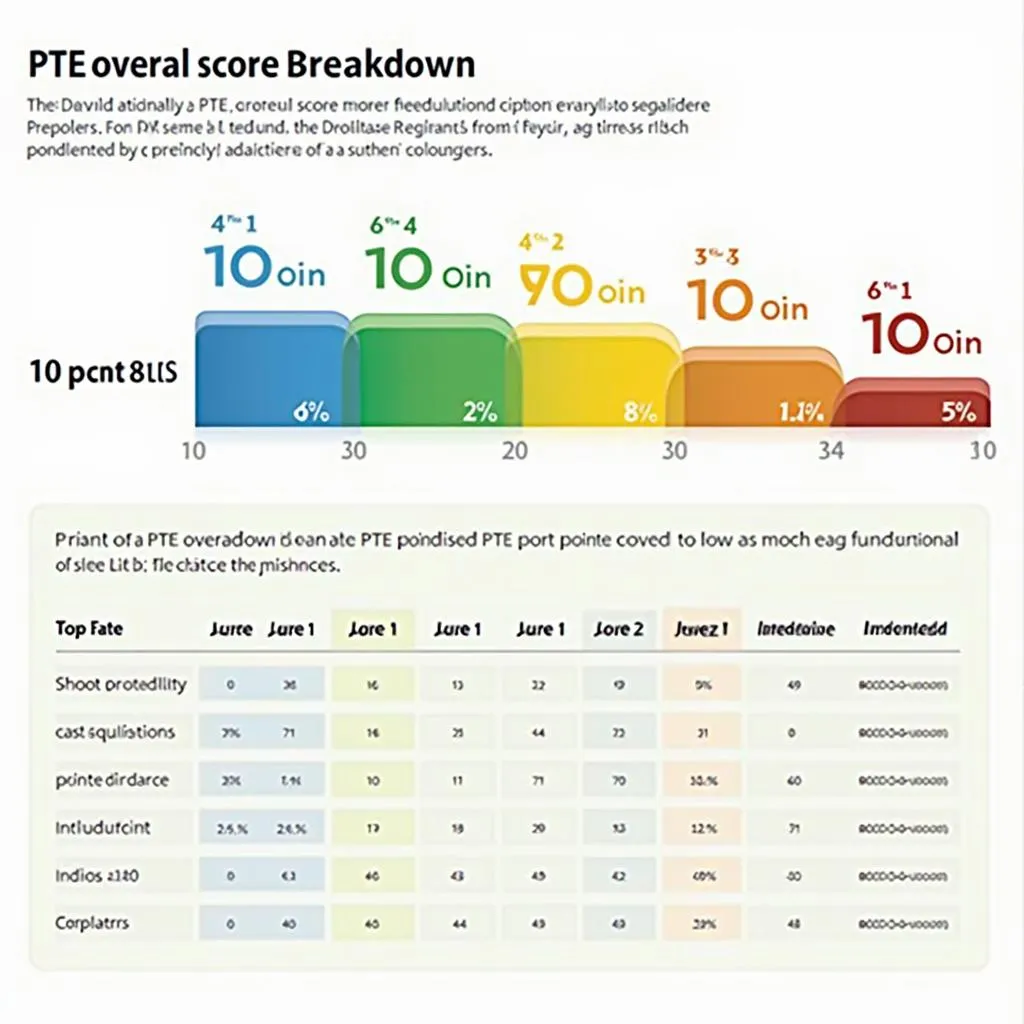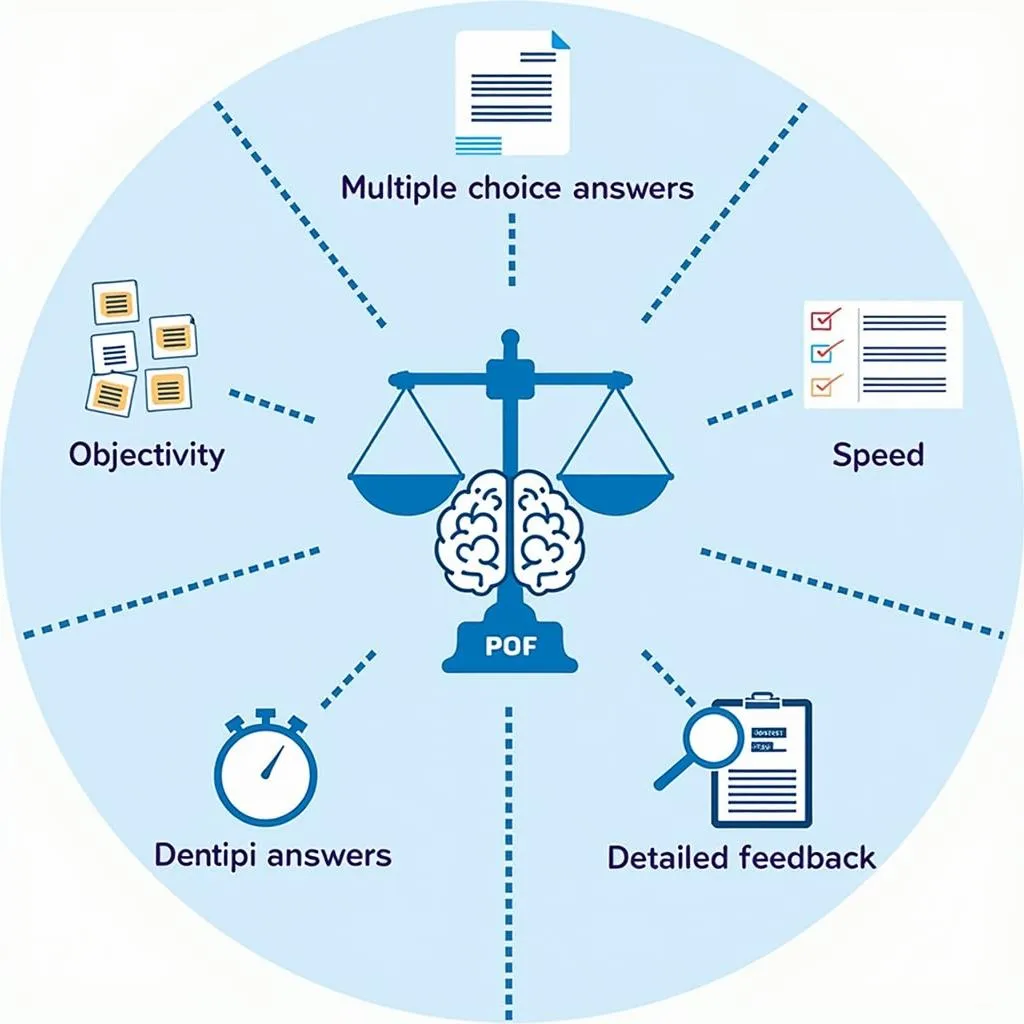Are you preparing for the PTE Academic exam and feeling overwhelmed by its scoring system? You’re not alone. Understanding how the PTE exam is scored is crucial for developing effective study strategies and achieving your desired results. In this comprehensive guide, we’ll break down the PTE exam scoring method, providing you with valuable insights to boost your performance.
The Basics of PTE Scoring
The Pearson Test of English (PTE) Academic uses a unique scoring system that combines automated scoring technology with human expertise. This approach ensures fair and consistent results across all test takers.
Overall Score
Your overall score in the PTE exam ranges from 10 to 90 points, reflecting your overall English language ability. This score is calculated based on your performance in the four communicative skills: speaking, writing, reading, and listening.
 PTE Overall Score Breakdown
PTE Overall Score Breakdown
Communicative Skills Scores
Each of the four communicative skills is scored separately on the same 10-90 scale. These scores provide a detailed picture of your strengths and weaknesses in different areas of English language proficiency.
Enabling Skills and Their Impact
In addition to the communicative skills, the PTE exam also assesses six enabling skills:
- Grammar
- Oral Fluency
- Pronunciation
- Spelling
- Vocabulary
- Written Discourse
These enabling skills are scored on a scale of 10 to 90 and contribute to your communicative skills scores. For example, your grammar and vocabulary scores directly impact your writing score.
PTE grammar exercises for high scores can significantly improve your performance in these enabling skills, ultimately boosting your overall score.
The Science Behind PTE Scoring
PTE Academic utilizes advanced automated scoring technology to evaluate your responses. This system analyzes various aspects of your performance, including:
- Content accuracy
- Language use
- Pronunciation
- Fluency
- Timing
Dr. Emily Chen, a leading expert in language assessment, explains:
“The PTE scoring algorithm is designed to mimic human raters but with the added benefit of consistency and objectivity. It considers not just what you say, but how you say it, providing a comprehensive evaluation of your English language skills.”
Item-Level Scoring
Each question or task in the PTE exam is scored individually. The scores for these items are then combined to calculate your communicative skills scores and overall score.
 PTE Item-Level Scoring Process
PTE Item-Level Scoring Process
Understanding Partial Credit
One unique aspect of PTE scoring is the concept of partial credit. Unlike some other language tests that use a right-or-wrong approach, PTE awards points for partially correct answers. This means you can still earn points even if your response isn’t perfect.
For example, in the PTE writing section scoring method, you may receive partial credit for addressing some but not all aspects of an essay prompt.
Tips for Maximizing Your PTE Score
Now that you understand how PTE scoring works, here are some strategies to help you achieve your best score:
- Practice time management: Complete tasks within the allocated time to avoid losing points unnecessarily.
- Focus on accuracy and fluency: Strive for a balance between speaking or writing quickly and maintaining accuracy.
- Address all parts of the question: Ensure you cover all aspects of multi-part questions to maximize your partial credit.
- Improve your enabling skills: Work on grammar, vocabulary, and pronunciation to boost your scores across all sections.
- Use effective summarizing techniques for reading and listening tasks.
Remember, as PTE expert Sarah Johnson advises:
“Success in the PTE exam isn’t just about knowing English; it’s about understanding the test format and scoring criteria. Tailor your preparation to address each aspect of the scoring method for the best results.”
The Role of AI in PTE Scoring
Artificial Intelligence plays a crucial role in the PTE scoring process. The AI-powered system analyzes your responses based on thousands of pre-scored examples, ensuring consistency and fairness.
Benefits of AI Scoring
- Objectivity: Eliminates human bias and mood fluctuations
- Consistency: Provides uniform scoring across all test takers
- Speed: Delivers results quickly, often within five business days
- Detailed feedback: Offers specific insights into your performance
 AI-Powered PTE Scoring System
AI-Powered PTE Scoring System
Common Misconceptions About PTE Scoring
Let’s debunk some myths about PTE scoring:
-
Myth: Native English speakers always score higher.
Fact: The test assesses your ability to use English in an academic context, not your accent or background. -
Myth: You need perfect pronunciation to score well in speaking.
Fact: While pronunciation is important, fluency and content also play significant roles in your speaking score. -
Myth: Longer responses always score better.
Fact: Quality and relevance are more important than length. Concise, accurate responses can score highly.
Preparing for Success
Understanding the PTE exam scoring method is just the first step. To truly excel, you need targeted practice and strategic preparation. Focus on improving your weakest areas while maintaining your strengths. Remember, consistency in your study routine is key to achieving your desired score.
As you continue your PTE preparation journey, keep this scoring guide in mind. By aligning your study strategies with the PTE scoring method, you’ll be well-equipped to tackle the exam with confidence and achieve the score you need for your academic or professional goals.
FAQs About PTE Exam Scoring
-
How long does it take to receive PTE exam results?
PTE results are typically available within five business days after taking the test. -
Can I request a rescore of my PTE exam?
Yes, you can request a rescore, but it’s rare for scores to change due to the automated scoring system. -
How does PTE scoring compare to IELTS or TOEFL?
While all tests assess English proficiency, PTE uses a unique AI-based scoring system that provides more detailed feedback on specific language skills. -
Is there a passing score for the PTE exam?
There’s no universal passing score. Required scores vary depending on the institution or organization you’re applying to. -
How can I improve my PTE score if I’ve plateaued?
Focus on improving your enabling skills, practice with timed conditions, and analyze your performance in each section to identify areas for improvement.
By mastering the intricacies of the PTE exam scoring method, you’re taking a significant step towards achieving your language proficiency goals. Remember, practice makes perfect, and with the right strategies, you can confidently approach the PTE exam and unlock new opportunities in your academic or professional journey.